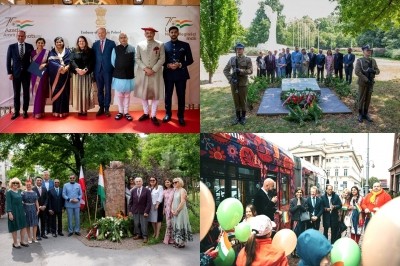
Mumbai, This week, the flavour of the season in Poland are the erstwhile Indian Maharajas - whose forefathers had sheltered thousands of Poles escaping from the horrors of World WarII - with the Polish government having a series of commemorative events in Warsaw and other cities.
The Poles are paying tributes to the then Chhatrapati of Kolhapur and Jam Saheb of Nawanagar (now, Jamnagar), and gratitude for how they had cared for the Poles fleeing German persecution and the aftermath of WWII.
Starting with a felicitation function on Tuesday, other visits are lined up in different cities to remember Shrimant Rajarshi Chhatrapati Sahu Maharaj of Kolhapur and Jam Saheb Digvijaysinhji Ranjitsinhji Jadeja of Nawanagar.
In those dark days, while Kolhapur had welcomed around 5,000 displaced Poles, Nawanagar threw the doors open for another 1,000, mostly orphans whose kin disappeared in Siberian concentration camps.
The visiting dignitaries include: Yuvraj Chhatrapati Sambhajiraje (the 13th direct descendent of Chhatrapati Shivaji Maharaj), his wife A.S. Sanyogeetaraje Chhatrapati Yuvradhni, and their son Yuvrajkumar Shahaji Chhatrapati of Kolhapur, Dr. Piyushkumar Matalia -- representing Shatrusalyasinhji of Nawanagar, Indian Ambassador to Poland (Ms) Nagma Mohammed Mallick, Indian Council for Cultural Relations President Dr. Vinay Sahasrabuddhe, and others.
Sambhajiraje mentioned how many people asked him why the then Chhatrpati Maharaj intervened to help the Polish and said it's the 'culture of Kolhapur'.
"This is the culture established by Chhatrapati Shivaji Maharaj and carried forward by the social reformer Rajarshi Chhatrapati Shahu Maharaj... The foundation of 'Swarajya' -- our Maratha Empire -- was to fight against injustice and 'Chhatrapati' literally symbolises 'protector' of the people," explained Sambhajiraje.
Dr. Matalia said the then Jam Saheb of Nawanagar was an Indian aristocrat who saved the displaced Poles, built special settlements, an orphanage for 1,000 Polish orphan in Balachadi, and in turn, the children showed their gratitude by referring to the Maharaja as 'Bapu' (Father).
Dr. Sahasrabuddhe, who called on the Polish Foreign Minister Zbigniew Rau - said he was overwhelmed to remember India's support and shelter to the Polish people during the WWII.
In turn, the ICCR head conveyed India's gratitude to Rau for helping rescue Indian students stranded in Ukraine a few months ago and Poland's help for the Operation Ganga project.
In May (2022), Ambassador Nagma Mallick had hailed the inauguration of a tram - 'Dobry (Good) Maharaja' - in Wroclaw by the town's Mayor Sutry Jacek, dedicated in memory of the Kolhapur and Nawanagar Maharajas, 83 years after they had saved the Polish people who fled to India.
The delegation toured the Monte Cassino War Memorial and paid tributes at the statue of a headless Nike, in the form of a 12-metre column and the base covered with a shroud and scattered helmets, the pedestal engraved with the Cross of Monte Cassino, emblems of 5 Polish units that fought the war, a Polish Eagle and an urn containing the ashes of the war-heroes.
From the Poland side, dignitaries interacting with the Indian delegation included Polish Ambassador to India Adam Burakowski, President of the Association of Poles (Valivade Camp) Jan Chendynski and Wieslaw Stypula (Balachadi Camp), Mazovia Province Governor Konstanty Radziwill, Undersecretary of State for Security Marcin Przydacz, Vice-Marshal of the Senate Bogdan Boruzewicz and Poland-India Parliamentary Friendship Group Chairperson Malgorzata Pepek.
This week's events came three years after the then Deputy Foreign Minister Przydacz visited Kolhapur to unveil a 'Memorial Pillar' at Valivade village, where the desperate Poles reached after Germany invaded Poland on September 1, 1939, triggering the devastating WWII.
The Poles fled via the land or sea routes, in trucks from Ashkhabad in the former USSR via Afghanistan or Iran, after two major evacuations by the Polish Army through the Caspian Sea in March and August 1942 at the height of the WW-II when the world was under the terror of the Chancellor of Germany Adolf Hitler.
"The 'Little Poland', while maintaining its distinct identity, coalesced with the local culture and community. I was pleasantly surprised when a Polish parliamentarian addressed me as 'Maharaj'. The Memorial Museum being set up will keep those memories alive," said Sambhajiraje in 2019.
After returning home, the Poles did not forget their generous Indian hosts and the Association of Poles (here) also erected an obelisk at the Mahavir Garden Park in Kolhapur with an eagle at the top.
In 2011, Poland conferred the "Commander's Cross of the Order of Merit of the Polish Republic" on Maharaja Jam Saheb Digvijaysinhji R. Jadeja posthumously, at least six public and private schools are named after him in Warsaw, while a prominent junction in the capital's Ochota district is dedicated as "The Square of the Good Maharaja" with his statue in 2013.
The Maharaja's contributions were immortalised in an Indo-Polish co-production film, 'A Little Poland In India' (2013), depicting him as the lone crusader who safeguarded the lives and future of thousands of orphaned Polish children who sought refuge during the dark days of WWII.
After the war horrors ended, a majority of those children returned to Poland but their memories for India and the two Maharajas continue to 'live' in the hearts of the Polish people.


.jpeg)

